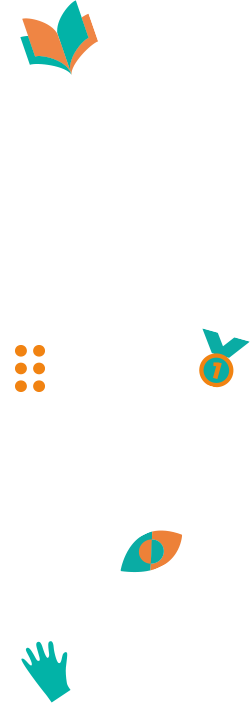16th competition, Lublin (Poland), 2024
The President opened the session by recalling the history of Typhlo & Tactus:
- 2000-2008 : European project with 10 blind and sighted judges.
- Since 2009 : meetings every two years between 8 countries committed to promoting sensory books for visually impaired children.
The current event features :
- 69 models presented
- 17 participating countries
- 7 judges and their pairs
- 2 conferences (not held)
- 3 days of exchange and work
Saturday, October 5th
- Start of model selection: each judge has between 4 and 6 minutes per model.
- Voting method: yes/no by a show of hands.
- Results:
- Selection varied from country to country (from 15 to 24 models).
- In the end, 25 designs were selected for the second stage.
Sunday, October 6th
- Qualitative analysis of the 25 shortlisted designs.
- Each judge shares his or her impressions, then awards marks using tokens (from 1 to 5 points).
- Compilation of results (on the site)
Monday, October 7th
- Awarding of special mentions:
- Didactic Mention
- Sensitive subject
- Play book
- Tactile daring
- Artist’s book
- Special mention Poland
- Discussions and show of hands to award the mentions.
Closing
- Visit to the faculty for the awards ceremony scheduled for the following day.
- Regretful cancellation of Bob, Pietro and Stefano’s lectures.
- Josée presents each judge with the book Coup de chapeau 2022, published by the Italian association Fiori Blue.
Positive elements :
- A new, fairer evaluation method: The introduction of rating tokens and special mentions has enabled a finer assessment of the models. This system better reflects the diversity of viewpoints and the richness of exchanges.
- Improved quality: The competition has become more rigorous and relevant. By working together, sharing experiences and comparing analyses, shared criteria emerged, consolidating a common culture of tactile books.
- A shared vocabulary: The analysis of the mentions enabled the group to develop a common language, essential for refining the selection. This is an important step towards the shared objective of offering quality sensory books to visually impaired children and audiences with special needs.
- Smooth organization: The three days were well structured. The group extends its warm thanks to Bob for his management and hospitality.
Areas for improvement :
- Fatigue at the end of the day: Concentration declines over time. It would be useful to distribute reading time more equitably, while ensuring fairness between countries.
- Meal times too long: This sometimes reduced the time available for work.
- Exchange sometimes scattered: some wasted time. Better discipline in taking the floor is desirable.
- Cancelled conferences: Their absence was regretted. It would be useful to consider remote formats (videoconferencing) to avoid losing this valuable content.
- Questions about mentions: While mentions enriched the analysis, they also raised questions. Why not revisit all the models? Some regretted that quality works had not been selected.
- Translation problems: The quality of exchanges could be enhanced with a bilingual translator familiar with the subject.
- Burden on organizers: Being both judge and organizer (as was the case for Bob) raises questions. It can affect the fluidity of the organization.
The 2024 edition in Lublin marked an important milestone in the history of Typhlo & Tactus, with significant methodological advances and a shared determination to move forward. Despite a few points requiring fine-tuning, the group continues to advance in its mission: to offer visually impaired children fair, sensitive and joyful access to reading.
15th competition, Padua (Italy), 2022
Two and a half days of work, the 7 judges discovered, explored, touched the different materials, read and enjoyed discovering all these original stories illustrated with sought after materials. The group wrote the following synthesis:
Positive elements :
- Fun and enjoyable walks for the children
- Several models presented riddles, nice interaction with the youngest
- Unusual themes: illness, emotions, art, topical subjects
- Texts in line with the images
- New objects from the daily life of blind children put into the story
- Good proportions between the objects in the story
- Choice of original materials that are pleasant to the touch
- Stories that allow inclusion from the outset
- New treatment of the tactile image (drawing or representation)
- Some texts are very poetic
- Some models stimulate the imagination and creativity
- They are whimsical and funny
- Some models help the child to build other “mental images
- Multi-sensory models give the reader other perceptions (hearing, smell, kinaesthetics, thermal sensitivity, baresthetics)
- Some are very sensitive, they approach the symbolic and the abstract
- Very well represented metaphors
- Techniques that lead children to surprises
- We discover playful, interactive texts
- Sometimes too identical materials
- Often very contrasting materials, which stimulate readers to continue
- Some models propose actions to the readers, either they are the hero of the story and choose the actions to be taken, or action verbs that stimulate the reading
- Some stories are really to be shared – children have the same skills to read thanks to the network of senses
- Formats adapted to small hands
Areas for improvement :
- Some models are not very aesthetic, it is more difficult to share with sighted children
- Complex texts compared to the images
- Sometimes the text evokes several ways of exploring the illustration, but it remains too simple
- Some materials are very rough, and therefore not very pleasant to touch, which is uncomfortable for readers
- Some stories are not finished
- Sometimes the illustration is too complex
- Some models lack interest,
- Some books remain poor in exploration
- Others are too complex
- Some layouts do not meet the criteria of books with tactile illustrations
- Some texts deserve to be more elaborate
- Sometimes there is a lack of narrative
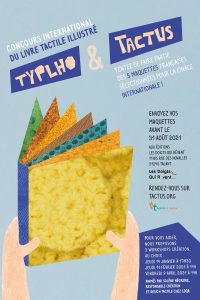
14th competition, Brussels (Belgium), 2019
All countries combined, the 18 participant countries received together 405 entries, with a record of 231 for Italy; each Typhlo & Tactus national partner received an average of 10 entries and selected an average of 4 for the international jury which received 61. The national selections took place at 37% in August, at 21% in September and at 16% in June.
At 81%, the 85 authors were women with an average age of 40, for who at 53% it was the first Tactile illustrated Book and who at 32% were participating in T&T for the first time. These authors were 16% of students of different disciplines, 13.8% of teachers, 10% from visually impaired backgrounds and 9% art.
The international T&T jury analyzed 61 entries over 2 days.
The discovery and reading of each entry demonstrate a work of reflection, originality and great creativity. This year new topics were covered such as feelings, emotions, and jobs. Several entries evoke ecology, for example the seabed. Some authors also apprehend concepts such as light or paintings by painters… In addition, we are also seeing new sizes (formats): more big books and more game books. All these entries introduce either new materials or original techniques and interesting tactile surprises.
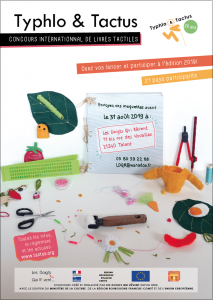
13th competition, Dijon (France), 2017
This year, 451 entries were presented in the various Typhlo & Tactus national competitions. Each of the 18 participating countries could send a maximum of 5 to the T&T international competition. Thus, 71 entries were presented in Dijon.
For this 2017 competition, the jury noted that the quality of the books has improved a lot:
- Many entries offer haptic, interactive illustrations that stimulate the interest of visually impaired children;
- The topics address new subjects such as emotions, abstract notions;
- The stories leave more and more room for the imagination;
- The choice of materials is relevant and there is a good complementarity between the text and the tactile illustration;
- Some entries promote parent-child interactions or are usable under the same conditions by blind and sighted children.
It is important that T&T continues to shine in the world. What a reward to hear a blind mother who had just read a tactile illustrated book to her sighted child, tell us: “This is the first time that I can read a book to my child” or this blind 6-year-old girl who, at the end of the day, reading a tactile illustrated book, takes my hands, puts them on her face and says “Touch my smile”.
Pictures:
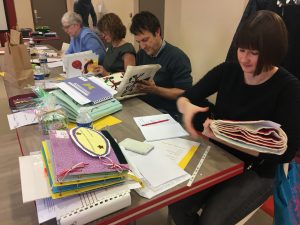
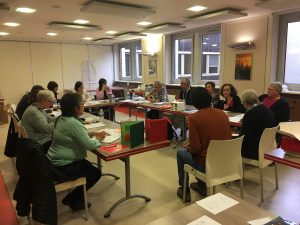
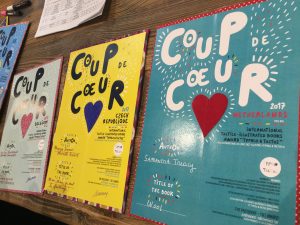
Here below you can download the 2017 results report:
Annoncement of the 1st, 2nd, 3rd prizes
United Kingdom Judge’s Favorite
12th competition, Cannero (Italy), 2015
In Italy a national project “A Spasso con le Dita” [Walk at your fingertips] born in 2010 from the collaboration between the National Federation for the Blind Olnus and ENEL Cuore Olnus to promote tactile publishing for children throughout the country. This project enabled, between 2010 and 2012, the creation and distribution for free of 5,000 tactile illustrated books in public libraries, pediatric hospitals and cultural institutions.
From 2013, an itinerant exhibition of tactile illustrated books has traveled all over Italy (Rome, Venice, Genoa, Bologna, etc.). In addition to the presentation of the books, didactic and fun workshops allowed the general public and children to discover the potential of multisensory illustration. Professional illustrators and artists have accepted the difficult challenge of making illustrations accessible to touch. National and local media have widely reported on the particularity and richness of this traveling exhibition.
Let us take inspiration from this Italian experience to promote the richness of the tactile picture in all blind and sighted children. Some experiences have shown its positive impact also on:
- Foreign children to access the language of the host country;
- Autistic and psychotic children and adolescents;
- Alzheimer’s patients.
Defend the idea of Philippe CLAUDET (founder and director of Les Doigts Qui Rêvent, and founder of T&T); a tactile illustrated book for blind child is an essential cultural prosthesis. The deaf child benefits from hearing aids which will allow him to access information and culture; disabled people receive a wheelchair, an essential prosthesis to promote their independence when they can no longer walk.
Despite these difficulties Typhlo & Tactus is increasingly recognized and is becoming an international reference.
- Philippe Claudet was invited in October to the International Book Fair in Frankfurt(Germany) by IBBY to present T&T
- The Bologna International Children’s Book Fair (Italy) is considering a stand and a tactile illustrated book exhibition for the next fair.
Here below you can download the 2015 results report.
11th competition, Helsinki (Finland), 2013
This year 2013, the Typhlo & Tactus competition took place in Finland. This country has provided significant resources in material and intellectual support for children’s and youth’s literature and its writers. This investment has positive spinoffs. Studies show that young Finns are among the most advanced in the world in terms of reading skills and attendance. We hope that education and cultural leaders around the world will learn from the Finnish example and support initiatives in favor of literature suitable for young children with visual impairments.
In 2000 four countries: Belgium, France, United Kingdom and Italy took part in T&T, the first world’s tactile illustrated book competition. This year 23 countries signed up to T&T. This significant increase in participants proves that the objectives set during its creation, have been achieved. Unfortunately for lack of funding and a recognized administrative structure, the award-winning books are no longer produced. How to solve this paradox, namely on one hand the increase of the creation of tactile illustrated books and on the other hand the difficulty to set an international production. However, the T&T competition without production is of little interest to children with visual impairments (or concerned).
Typhlo & Tactus is recognized by:
researchers specializing in tactile pictures and touch:
- Yvette HATWELL: professor emeritus then honorary professor at Pierre Mendès France, University in Grenoble;
- Édouard GENTAZ professor at the Faculty of Psychology and Educational Sciences at the University of Geneva;
- Annie VINTER professor of psychology at the University of Dijon;
- Bernard Darras, professor of semiotics and intercultural studies at the University of Paris 1-Sorbonne.
and international institutions:
- ICEVI (International Council for Education of People with Visual Impairment);
- IBBY (International Board on Books for Young People).
For this T&T 2013 competition, the jury noted that from one end of the world to the other there were common themes:
- on chickens, butterflies;
- on interactive means: discovery of objects;
- on handling pocket closures;
- on research: shoes, animal.
Many of the models were made of fabric, often with real objects, which made the entries bulky. The stories deserve to be more original. In order to address the weaknesses noted this year, the T&T jury will give itself the means of reflection to stimulate national creations.
Here below you can download the 2013 results report:
10th competition, Prague (Czech Rep.), 2011
More and more tactile entries are arriving. This year around 350 entries were made for the Typhlo & Tactus competition, the record being held by Italy with 210 entries! To limit sending a maximum of 5 books to the international competition, each country made a national selection with sighted and blind people.
The jury noted an improvement in the quality of the entries, in the use of increasingly evocative materials and in the new themes addressed.
Here below you can download the 2011 results report:
9th competition, Dijon (France), 2009
Some entries are still too big and too heavy for children and the tactile picture is still too often visual based. However, the jury noted improvements:
- New themes such as pregnancy;
- New techniques: introduction of movements (the horse), animal which “slides” from one page to another (the snake), pretending to be blind, pages cut out to reveal the main object which is on the last page, page numbering with buttons, pearls, small stones, Braille on aluminum paper.
The stories are more and more interactive with elements to be moved thanks to Velcro®, objects hidden under a fabric, behind a “shutter” etc..
We have seen the use of new material: thick aluminum foil, different emery cloth, anti-slip mat, etc..
8th competition, Dijon (France), 2007
End of the 3 years of the Typhlo & Tactus project with European subsidy.
This year the jury saw an effort to make the entries interactive. Many items were made from sewn fabrics. The jury admired their beauty. However, their reproduction is difficult and would distort their tactile qualities. If the T&T project is renewed, we count on national members to advise and guide the authors of tactile illustrated books in order to enrich the quality of the texts.
For all members of the jury, the T&T competition is a highlight. This unique opportunity in the world, where ten countries come together around tactile illustrated books, exchange their techniques, mutually bring their knowledge, is essential and the T&T founding members want the T&T adventure to continue.
Can it stop now when T&T is starting to be known worldwide? As proof, Korean television came to report on the work of the T&T competition jury and Mr. John Tuck, responsible for the British collection of the National Library of England, honored us with his presence.
Following this edition, 1,144 copies of the three awards were produced in Dutch, English, Finnish, French, German, Italian and Polish.
7th competition, Dijon (France), 2006
This year, again, we see a weakness in the writing of the texts. On the other hand, the illustrations are a source of real research and several entries present original concepts.
For 7 years, an increasing number of entries have come to us, which shows a need for tactile illustrated books and also a cruel lack of these books on the European or even world market.
In addition to the interest aroused by this competition, the jury notes that the range of authors is widening: at the beginning the entries were produced by professionals and parents. Currently, fine arts students, illustrators and authors are presenting original works for the Typhlo & Tactus competition.
The reflection, led by the T&T founding members, is an important and indispensable action for young blind children. Indeed, they only have contact with children’s literature and Braille writing through these books. These must therefore exist and be of excellent quality.
Following this competition, 1,129 copies of the three awards were produced in Dutch, English, Finnish, French, German, Italian, Polish and Czech.
6th competition, 2005
The members of the Jury noted that the graphic quality of the entries is clearly improving. This progress is due to the emulation generated by the TYPHLO & TACTUS competition. The first objective of the T&T Charter has been achieved this year.
There is a general opinion that the texts and content are often weak and lacking in originality. The texts are often enumerative and recurring themes are found for example the animal which is alone and which seeks a friend etc. It would be interesting that the T&T national partners spread the information released by the Jury:
- Congratulate the illustrators for the quality of the work provided, the originality of the illustrations and the handwork of their entries;
- Stimulate authors to invent innovative texts on themes that are little discussed: emotions, current themes (racism, violence, etc.) and non-figurative topics.
Following this edition, 1,094 copies of the three awards were produced in Dutch, English, Finnish, French, German, Italian and Polish.
5th competition (2004)
Following this edition, 1,155 copies of the three awards were produced in English, Finnish, French, German and Italian.
4th competition (2003)
Following this edition, 1,340 copies of the three awards were produced in English, Finnish, French, German and Italian.
3rd competition (2002)
Following this edition, 630 copies of the two awards were produced in English, Finnish, French and Italian.
2nd competition (2001)
Following this edition, 570 copies of the 1st prize were produced in English, Finnish, French and Italian.
1st competition (2000)
Following this edition, 609 copies of the 1st prize were produced in English, French and Italian.

